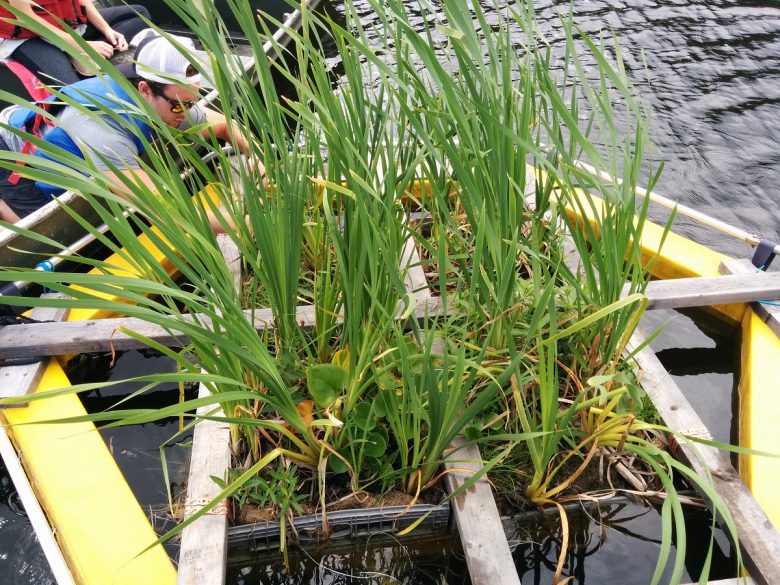Research October 1, 2015
The Floating Bioplatforms of IISD-ELA
By Richard Grosshans, Senior Research Scientist
Shallow lakes are one of the most common types of lakes globally and, because of their shallow nature, are often the most heavily affected.
Urbanization, landscape changes and expansion of agriculture cause excessive loading of nutrients, contaminants and organic materials to these water bodies. Aquatic plants, particularly the large emergent plant cattail (Typha), have an ability to absorb substantial nutrients (i.e., phosphorus and nitrogen) and break down contaminants. Plants take up and remove these elements from the sediment and water column into their plant material or biomass. The more plants in a water body, the greater the capacity to absorb and remove excess nutrients, which makes biological remediation possible. In spring 2015, floating wetland bioplatforms were deployed in two lakes at IISD-ELA to look at the ability of cattail plants growing on floating platforms to take up and remove nutrients, and the impacts of eutrophication. This project is an extension of IISD’s bioeconomy research program.
For the past decade, IISD’s bioeconomy research has explored sustainable water and land management that creates opportunities for economic growth that can actually improve the environment. IISD’s Netley-Libau Nutrient-Bioenergy Project first showed that, by harvesting cattail, nutrients (i.e., phosphorus) taken up during growth and stored within the plant are permanently removed from the soil. The harvested biomass is then a valuable feedstock for solid fuel, biofuels and bioproducts. IISD has since implemented this integrated approach within large water retention projects in Manitoba and Minnesota used for flood control, where storing water on the land also captures nutrients and provides excellent conditions to grow cattail.

The use of wetlands and plants to capture and remove contaminants and nutrients is widely practiced around the world for wastewater treatment and watershed nutrient control. Despite this, little is applied in North America. Floating mats of plants, or bioplatforms, are a technique used for water treatment, erosion control and habitat, and are a potential alternative biological approach for storm water ponds, wastewater lagoons and in lakes. Eutrophic water bodies create conditions for plant growth, not unlike hydroponics, and the floating bioplatforms allow plants to grow in water that is typically too deep to allow them to become established.
The acquisition of the Experimental Lakes Area (IISD-ELA) in 2014 provided an opportunity to enhance the IISD Water program’s lake remediation research with an active in-lake demonstration. This project, funded by the Government of Manitoba, seeks to identify strategies applied in other parts of the world appropriate for eutrophic lakes in Manitoba. Four floating bioplatforms were deployed at IISD-ELA in June 2015: two in Lake 227 (the lake famous for phosphorus additions since 1969) and two in Lake 114 (as a natural background lake). The bioplatforms were constructed utilizing floating rings with a hanging 2-by-4 frame inside to provide support for trays of cattails. Cattail plants, rhizomes and soil were obtained from a donor site on the IISD-ELA camp road. Plant growth and nutrient uptake was monitored during the growing season, and the differences observed between the two lakes by mid-August were staggering. The hypothesis was that excess phosphorus in Lake 227 would enhance cattail nutrient uptake and potentially cattail growth. Early results show this clearly, with greater plant productivity in Lake 227 bioplatforms, confirming cattail’s love for phosphorus as fertilizer.
In 2016, further graduate research will more closely compare the function of the bioplatforms and the life cycle of phosphorus uptake, and run a comparison of bioplatforms deployed in Manitoba and the Atlantic provinces. IISD is collaborating with colleagues in the Netherlands, who also deploy floating bioplatforms and are sharing knowledge for lake remediation. There is, of course, potential for integration of the floating bioplatforms in other IISD-ELA research, for example, to measure uptake of elements related to current IISD-ELA research interests such as mercury, cadmium or nanosilver, and for use in future ELA research.